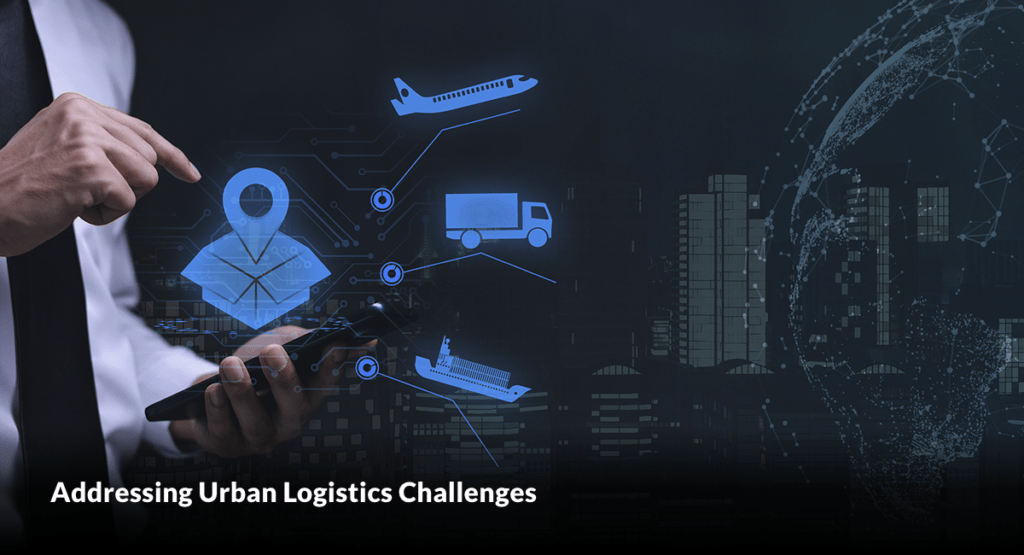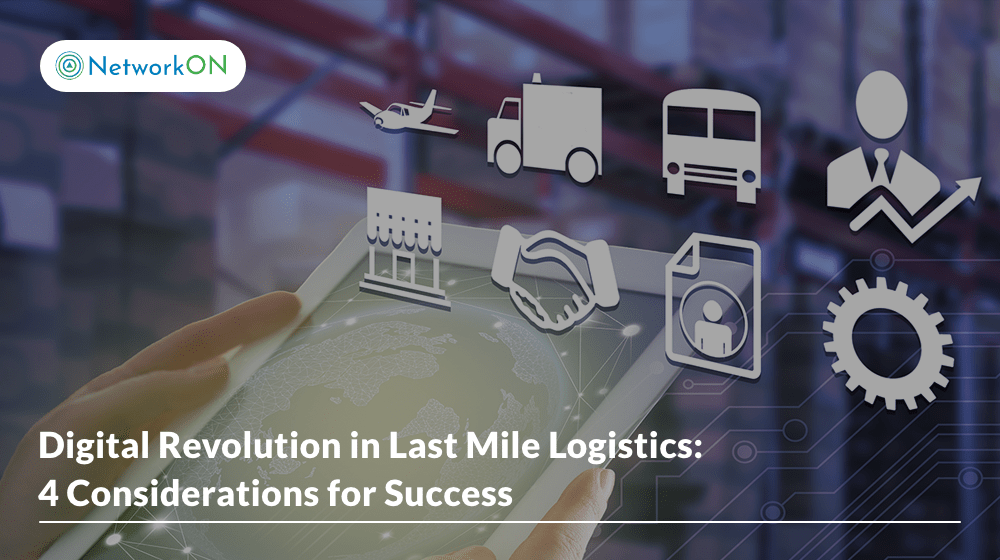Table of Contents
Key Takeaways:
- Digital Revolution transforms last-mile logistics, necessitating smart strategies.
- Data analytics and AI optimize delivery processes, turning data into actionable insights.
- Customer experience is pivotal, utilizing real-time tracking, personalized windows, and feedback mechanisms.
- Balancing delivery speed and quality ensures customer loyalty and satisfaction.
- Sustainability is a key branding element, with digital advancements enabling eco-friendly delivery practices.
- NetworkON emerges as an innovative solution with GPS integration and dynamic routing for efficient last-mile logistics.
In the world of last-mile logistics, the fast-paced evolution of digital technology transforms how products journey from fulfillment centers to customers’ doorsteps. The Digital Revolution in Last Mile Logistics is not just about keeping up with the trends—it’s about staying ahead of the curve with smart, tech-driven strategies.
In this comprehensive look, we’ll delve into the latest advancements in logistics technology that are shaping the future of delivery services. Prepare to be at the forefront of an industry in transformation!
1. Utilizing Data Analytics and AI for Smarter Deliveries
The digital revolution in last-mile logistics is not only about getting goods to consumers; it’s about doing it in the smartest way possible. By harnessing the power of data analytics and AI, businesses are turning the final leg of the delivery journey into a source of competitive advantage.
Data Analytics in Last Mile Delivery Optimization
Data is king in the quest for flawless last-mile delivery. Data analytics allows retailers to dissect complex delivery patterns and consumer behaviors, turning them into actionable strategies. By understanding the when, where, and how of successful deliveries, retailers can make informed decisions to streamline their operations.
- Breaking down delivery data: Retailers are using data analytics to gain insights into delivery times, customer satisfaction levels, and route efficiency.
- Success stories: Companies such as Amazon and UPS have transformed their delivery models by analyzing vast datasets to predict customer needs and adjust their delivery strategies accordingly.
Leveraging AI and Machine Learning
AI and Machine Learning are not just buzzwords—they’re game-changers in the logistics industry’s journey towards efficiency. By integrating AI, retailers can significantly reduce operational costs and expedite deliveries. This technology processes millions of data points to suggest the most cost-effective and time-saving routes.
- Cost reduction and delivery speed: AI algorithms consider traffic patterns, weather conditions, and vehicle capacity to recommend optimal delivery routes.
- Predictive analytics for demand forecasting: AI-driven analytics helps businesses anticipate demand spikes, enabling them to prepare for future challenges efficiently.

2. Prioritizing Customer Experience
With the growing stature of the digital revolution in delivery operations, businesses must understand that the final step of the delivery process is crucial for customer satisfaction. A positive last-mile experience can be a significant differentiator in a competitive market. Let’s explore how prioritizing customer experience can make or break your success in the digital era.
The Importance of Customer Experience in Last Mile Delivery
In instant gratification, the direct link between customer satisfaction and last-mile delivery performance has never been more pronounced. Technology plays a pivotal role in enhancing customer interaction and communication during delivery. Real-time tracking, personalized delivery windows, and seamless communication channels are just a few examples of how businesses are leveraging technology to raise the bar on customer experience.
- Personalized Delivery Windows: Allowing customers to choose delivery slots that suit their schedule.
- Real-time Communication: Keeping customers informed with live updates about the status of their deliveries.
- Feedback Mechanisms: Providing a platform for customers to share their delivery experience immediately, enabling businesses to address any concerns promptly.
By implementing innovative strategies, companies meet and exceed expectations, personalizing deliveries and winning customer loyalty.
The Impact of Delivery Speed on Consumer Loyalty
Modern consumers expect swift deliveries, often on the same day or within hours. This expectation has set the bar high for businesses aiming to maintain consumer loyalty. Fast delivery can be a compelling reason for customers to choose one service over another.
However, it’s crucial to balance speed with quality. Rapid delivery should not result in damaged goods or errors. To ensure success in last-mile operations, consider these actionable advice:
- Optimize Routes: Use advanced routing algorithms to reduce delivery times efficiently.
- Local Warehouses: Position products closer to customers by utilizing urban micro-warehouses.
- Outsource to Delivery Specialists: Collaborate with expert logistics partners that can scale with demand and maintain delivery standards.
By focusing on a strategy that prioritizes both speed and the quality of service, businesses can fulfill the high expectations of modern consumers, thus strengthening consumer loyalty and fostering long-term relationships.
3. Addressing Urban Logistics Challenges
The last stretch of the delivery process—the last mile—poses distinctive challenges within urban environments’ buzzing and congested streets. Let’s dive into how digital tools overcome the concrete jungle’s obstacles and pave the way for faster, smarter deliveries.

Challenges and Solutions for Urban Logistics
Identifying common obstacles in urban last-mile delivery means acknowledging the tight grip of traffic congestion and the often frustrating limitations on access to certain areas. How can deliveries reach high-rise apartments swiftly when elevators are slower than molasses and roads are as jammed as your favorite radio station’s top hits? Enter the heroics of technology.
- Advanced route optimization software slinks through the traffic, using real-time data to guide drivers along the quickest paths.
- Electronic cargo bikes and automated delivery bots sidestep the grind, delivering parcels efficiently in zones personal cars can’t reach.
- Drones? They’re not just for stunning aerial shots anymore—they’re becoming the delivery birds of the digital age, cutting through the urban sky with ease.
Examples of digital solutions lifting up distribution in dense cityscapes are everywhere. For instance, crowd-sourced delivery platforms allow passengers and commuters to deliver parcels en route to their destinations, making every trip a potential delivery run. And smart lockers? They stand guard in convenient locations, offering secure and accessible points for customers to pick up their goods at their leisure.
Collaboration Between Retailers and Last Mile Carriers
Let’s talk about the power move: Collaboration. The alliance between retailers and last-mile carriers kicks inefficiency to the curb. Together, they weave a tight network with collective intelligence and seamless communication.
- Shared technological platforms ensure that everyone’s singing from the same digital hymn sheet, harmonizing the movement of goods with a symphony of synced data points.
- Partnership strategies might include co-developed apps that keep customers in the loop with real-time updates or shared warehousing solutions that enable rapid distribution.
So there you have it: the digital revolution is not just changing how we think about the last leg of delivery; it’s revolutionizing it for the bustling, bright lights of urban landscapes. By embracing digital solutions and fostering partnerships, the prophets of the pavement are turning logistic nightmares into streamlined dreams.
4. Committing to Sustainability in Last Mile Operations
As we navigate through the Digital Revolution in Last Mile Logistics, a pivotal element is increasingly becoming a cornerstone of business branding—sustainability. Consumers today are not just concerned with how fast their packages arrive, but also with the environmental impact of their delivery.
Sustainability Practices in Last Mile Deliveries
The transition towards a more sustainable future is a moral choice and a competitive edge. Advances in technology provide the perfect ally for enhancing the eco-friendliness of delivery options. Here are some ways digital advancements have opened the door to greener delivery methods:
- Using electric or hybrid delivery vehicles equipped with GPS and route optimization software to reduce emissions.
- Implementation of package consolidation algorithms to lower the number of trips required.
- Investment in drone or autonomous delivery systems that promise a decrease in carbon footprint.
What’s more, companies aiming for sustainability in their delivery processes can take significant steps, such as:
- Opting for sustainable packaging materials and minimal packaging designs.
- Encouraging customers to choose “green” delivery options, such as a “no rush” option that aligns multiple deliveries efficiently.
- Establishing local distribution centers to shorten delivery distances.
- Offering incentives for customers who participate in recycling or return programs.
In conclusion, committing to sustainability in last-mile logistics is not just about keeping up with a trend. It’s about embracing a necessity that can drastically improve your brand’s value and ensuring that the benefits of the Digital Revolution extend to the environment we all share.
Wrapping Up
In last-mile logistics, we’ve explored the vital role of technology, data analytics, and the imperative of delivering exceptional customer experiences. Tackling urban distribution challenges and integrating sustainability into operations has been a key focus.
These considerations form the blueprint for companies aiming to stay relevant in a fiercely competitive market. Adopting the latest logistics technology and strategies provides a significant competitive edge, allowing businesses to keep pace and lead change in this agile and forward-thinking industry.
Choosing the right technology partner is critical, and NetworkON, a cutting-edge delivery management software, stands out as a comprehensive solution. Advanced GPS and RFID integration offers real-time visibility and tracking, ensuring accurate information about deliveries. Its dynamic routing optimizes routes in real time for efficient and timely deliveries.
NetworkON’s user-friendly interface and mobile app empower businesses to offer customer-centric delivery options, creating a seamless and personalized experience. In conclusion, as businesses navigate the digital revolution in last-mile logistics, NetworkON emerges as an innovative solution, ready to elevate operations and set the pace in this dynamic industry.
To know more, write to us at info@networkon.io or visit our website.
Frequently Asked Questions:
What is the Digital Revolution in Last Mile Logistics, and why is it significant?
The Digital Revolution in Last Mile Logistics refers to the transformative impact of digital technology on the final leg of the product delivery process. It is significant because it reshapes how goods move from fulfillment centers to customers’ doorsteps, demanding innovative strategies to stay ahead in a tech-driven industry.
How does data analytics play a role in optimizing last-mile delivery?
Data analytics is crucial in optimizing last-mile delivery by providing insights into delivery patterns, consumer behaviors, and operational efficiency. Retailers use data to enhance delivery times, customer satisfaction, and route efficiency, as companies like Amazon and UPS exemplify.
What role do AI and Machine Learning play in route optimization for last-mile deliveries?
AI and Machine Learning significantly contribute to route optimization by processing vast amounts of data, considering traffic patterns, weather conditions, and vehicle capacity. This technology helps reduce operational costs and expedite deliveries by recommending cost-effective and time-saving routes.
How does prioritizing customer experience impact the success of last-mile logistics in the digital age?
Prioritizing customer experience is crucial in the digital age, as it can be a significant differentiator in a competitive market. Technologies like real-time tracking, personalized delivery windows, and feedback mechanisms enhance customer satisfaction, leading to increased loyalty and success in the last-mile logistics industry.
What advice is provided for balancing delivery speed and quality of service?
To balance delivery speed and service quality, businesses are advised to optimize routes using advanced algorithms, position products in local warehouses for quicker access, and collaborate with expert logistics partners. This strategy ensures swift deliveries without compromising on the quality of service.
How do digital solutions address challenges in urban last-mile logistics?
Digital solutions address urban logistics challenges by utilizing advanced route optimization software, electronic cargo bikes, automated delivery bots, and even drones. These technologies navigate through traffic, overcome access limitations, and provide efficient delivery solutions in dense urban environments.
What role does collaboration between retailers and last-mile carriers play in optimizing delivery operations?
Collaboration between retailers and last-mile carriers is a power move that eliminates inefficiencies. Shared technological platforms and partnership strategies, such as co-developed apps and shared warehousing solutions, ensure synchronized movement of goods, enhancing efficiency in last-mile delivery operations.
How does the article emphasize the importance of sustainability in last-mile logistics?
The article underscores the growing importance of sustainability in last-mile logistics, highlighting it as a cornerstone of business branding. It explores digital advancements, such as electric vehicles, package consolidation algorithms, and drone delivery systems, as ways to make last-mile deliveries more eco-friendly.





0 Conversations